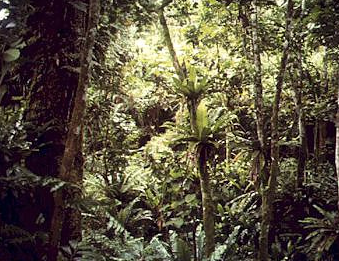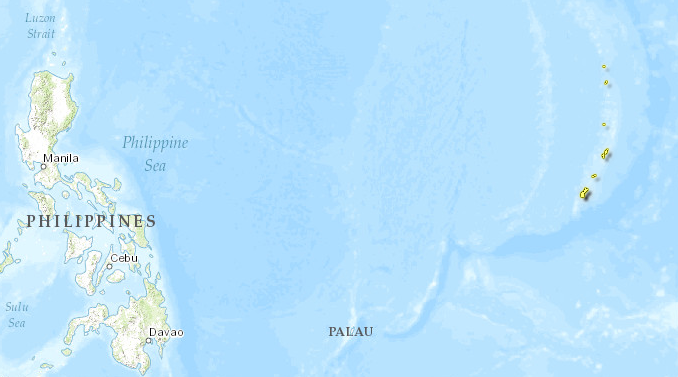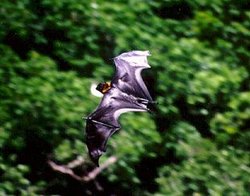Marianas tropical dry forests
Introduction A classic example of a volcanic island arc, the Mariana Islands extend about 900 kilometers (km) north-south along the edge of the Mariana Trench in western Micronesia. Although floristically rather species-poor, the Marianas nevertheless provide a biological journey through geologic time (Marianas tropical dry forests) , ranging from the 30 million-year-old island of Guam in the south to the still-active volcano, Farallon de Pájaros, in the north. These islands are home to several endemic and endangered species, some of which are in a critical state. Native forest has been degraded to a large extent, and though more protective measures have been put in place, introduced species such as the brown tree snake, continue to threaten the islands’ unique wildlife.
Location and General Description
The climate of the Mariana Islands is tropical with little seasonal temperature change and average monthly temperatures ranging from 24 to 27 ºC. Annual precipitation, which averages between 2,000 and 2,500 millimeters (mm), is strongly seasonal with heavy rains from July through October. Trade winds are fairly constant, but there is often a weak westerly monsoon influence in summer. The Marianas are also subject to frequent severe storms and typhoons, averaging about one typhoon per year.
The islands can be divided into two distinct groups: the northern, geologically young islands still have some active volcanism; the older southern islands are composed of elevated coral limestone and older weathered volcanic sequences. The islands of the northern group are dominated by primary grasslands, and show little human disturbance; those in the southern group have been heavily disturbed and are now mostly covered with secondary forest. Throughout the islands, there is a fairly low diversity of flora with probably no more than 500 species, including both native and naturalized plants.
Because of recent volcanism, there is little forest on the nine main islands of the northern Marianas. On older, gently sloping rough lava flows, there are occasional patches of mixed-species forests. The indigenous ironwood tree, Casuarina equisetifolia, locally known as gagu, is one of first tree species to colonize lava flows, along with a fern species, Nephrolepsis hirsutula. On the four smaller islands, which have no goat grazing, patches of forest dominated by Pisonia grandis can be found.
Remnants of a mixed broadleaf forest (Aglaia-Elaeocarpus) exist on the four larger islands of Agrihan, Pagan, Sarigan, and Anatahan. Two key species in this forest type are the mapunyao (Aglaia mariannensis), an understory tree endemic to the Mariana Islands, and the yonga (Elaeocarpus joga) which is endemic to Micronesia. The mapunyao is found in the forest understory on most of the islands because it can grow on either limestone or volcanic soils. The yonga is usually a large tree with a spreading crown, although in the Marianas it is usually stunted by typhoons and reaches heights of only about 15 meters (m). This tree has a bright blue berry which is a favorite food of birds, especially fruit doves. Obha considers the Aglaia-Elaeocarpus forest type to be the upland climax forest for the larger Northern Mariana Islands.
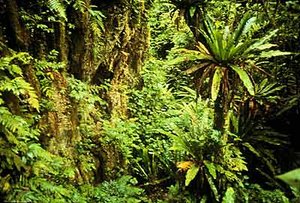 Rota Island, North Marianas Islands, USA. (Photograph by U.S. Fish & Wildlife Service)
Rota Island, North Marianas Islands, USA. (Photograph by U.S. Fish & Wildlife Service) Asuncion has been more thoroughly studied than many of the other islands in the northern group. A steep volcanic cone 891 m in elevation, it last erupted in 1906, but active fumaroles were observed as recently as 1996. The most extensive forest type on this currently uninhabited island is a scrubby, mixed-broadleaf forest dominated by Terminalia spp. These deciduous, indigenous trees have edible kernels that may have been favored by early human inhabitants. The seed of the tree is dispersed by fruit bats which feed on the husk. Terminalia is found on the southern slopes of Asuncion above the coconut groves and on lower slopes around the western side of the island. It appears to be the best developed native forest type currently occurring in the chain north of Saipan. Other woody plants found both in the forest and in adjacent ravines and coastal thickets include Pandanus, Premna, Pisonia, Neisosperma, Trema, Ficus, Pipturus, Erythrina, and Hibiscus tiliaceus.
Asuncion is home to approximately 400 endemic Mariana flying fox (Pteropus mariannus), and 25 bird species, including the Micronesian starling (Aplonis opaca) and the Micronesian honeyeater (Myzomela rubrata).
The southern Mariana Islands consist of masses of older volcanic rock, much of which resulted from submarine explosions. The islands are partially to completely covered with caps and terraces of reef limestone (ranging from ancient to modern). Tectonic movements have raised them as high as 474 meters above sea level. Their modern character has been shaped by a chaotic past, involving repeated sea level changes, faulting, coral reef development, uplift and erosion. There has been no volcanic activity since the Miocene, and some of the land on Guam may have been exposed for the past 25 to 30 million years. The volcanic portions of Guam are characterized by many streams and complex drainage patterns. The soils are either highly weathered lateritic clays (oxisols or ultisols) or very young inceptisols.
The limestone areas of the southern islands have terraces and cliffs of hard limestone that are covered by thin to moderately thick soils or, in some areas, are bare and karst-weathered, with soil found only in pockets and cracks in the limestone. Most of the karst topography has been weathered to rounded forms, with low relief. There is no surface water in this terrain.
Remnants of a primary limestone forest on Saipan, surveyed by Craig, indicated that Pisonia grandis was the dominant tree species in this forest type, with Dendrocnide latifolia, Cynometra ramiflora, Intsia bijuga, and Erythrina variegata very common. Also common are Premna serratifolia, Ficus prolixa, and P. tinctoria. The endemic genus Guamia which has only a single species, Guamia mariannae, is sparse in the canopy, but common in the understory.
Most of Guam, the largest and southernmost island of the Mariana chain, is covered by secondary growth forest. However, scattered patches of possibly original forest still exist on the northern plateau and in less accessible areas. Two major substrate types have been identified:
- Northern Limestone Vegetation was described by Fosberg as "moist mixed-species" forest, with 5 variations: Artocarpus-Ficus (dominated by A. mariannensis, a tall wild breadfruit, and F. prolixa, a large banyan); Mammea (dominated by M. odorata, which is lower in stature and found on the eastern escarpment); Cordia (an open scrub forest dominated by C. subcordata, found on steep slopes and cliffs); Merrilliodendron-Ficus (dominated by M. megacarpum and F. prolixa, 30 to 45 m tall); and Pandanus forest (dominated by P. tectorius).
- Southern Volcanic Soil Vegetation consists of grasslands with patches of forest occurring in ravines. Common trees of the ravine forests include Pandanus tectorius, P. dubuis, Hibiscus tiliaceaus, Ficus prolixa, Glochidion mariannensis, and Premna serratifolia. Leucaena leucocephala, introduced from the American tropics was widely planted after World War II and now grows in locally dense thickets.
Biodiversity Features
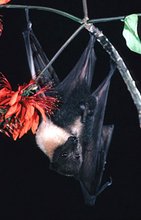 Guam flying fox (Pteropus mariannus). (Photograph by Bat Conservation International)
Guam flying fox (Pteropus mariannus). (Photograph by Bat Conservation International) A number endemic plants occur in the Marianas, including the critically endangered Serianthes nelsonii (endemic to Guam and Rota), the endangered Succinea piratarum and Succinea quadrasi, and the vulnerable Aglaia mariannensis, Heritiera longipetiolata (only in crevices of rough limestone, often on cliffs, in Saipan, Tinian, Rota, and Guam). Only 4 individual H. longipetiolata trees remained on Guam in the mid-1980s.
Several endangered or extinct land snails have occurred in the Marianas as well.
Of the 12 restricted-range birds found in the Marianas, seven are strictly endemic. A number of these restricted-range species are threatened, including the critically endangered Mariana crow (Corvus kubaryi) and Rota bridled white-eye (Zosterops rotensis), the endangered Micronesian megapode (Megapodius laperouse), Guam swiftlet (Collacalia bartschi), Nightingale reed-warbler (Acrocephalus luscinia), and vulnerable Tinian Monarch (Monarcha takatsukasae) and golden white-eye (Cleptornis marchei). Three other species are extinct or extinct in the wild.
Two native mammals are extant in the ecoregion. The endangered Marianas flying-fox (Pteropus mariannus) is well-distributed throughout the Marianas, but is restricted to inaccessible cliff limestone vegetation or interior volcanic ravine forests. The Polynesian sheathtail bat (Emballonura semicaudata) hangs on in the Northern Marianas island of Aguijan. Another bat species, the extinct Guam flying-fox (Pteropus takudae), was last seen in the 1960s.
Asuncion is unique in the Marianas in having a native Terminalia forest, where the principal species appear to be endemic. It also provides habitat for the endangered Marianas megapode (Megapodius laperouse laperouse), and the skink Emoia slevini, which was formerly known only from Guam, Rota, and Tinian. Asuncion is the largest of the Mariana Islands that remains uninhabited by humans, and free of cattle, pigs, and goats.
Current Status
Humans have had a major influence on the ecosystems of the Mariana Islands for at least 3,500 years. Over time, a general clearing (Deforestation) and burning of forests on volcanic soils has created either secondary forest or savanna. This has caused soil erosion and loss of nutrients after frequent heavy rains. In areas of limestone soils, which are more fertile than volcanic soils, the forests were cleared for coconut plantations, fields, and gardens. A major forest species, Intsia bijuga, has been mostly logged out. A great deal of habitat was also destroyed or altered during World War II. Abandoned cleared land reverts to a tangled secondary growth, dominated by introduced woody plants such as Triphasia trifolia, Jatropha gossypifolia, Pithecellobium dulce, Muntingia calabura, Cananga odorata, and especially Leucaena leucocephala.
In 1993, a National Wildlife Refuge was established on Guam to protect the remaining forest and the habitat of the Mariana crow (Corvus kubaryi) whose status is considered critical. Four of the northern islands—Farallon de Pájaros, Maug, Asuncion, and Guguan—are also wildlife sanctuaries.
Types and Severity of Threats
A major threat to birds is the potential spread of the introduced brown tree snake (Boiga irregularis), an Australasian native, from Guam to the other Marianas islands. Two bird species extinctions have already occurred on Guam in the 1980s, and the endemic Guam rail (Gallirallus owstoni) is extinct in the wild. The snake numbers on Guam have declined with the bird population, but the snakes are now feeding on an introduced skink, which allows them to maintain their population. Also, the introduction of the black drongo (Dicrurus macrocercus), a passerine bird native to Africa, Asia, and Australia, has been implicated in the rapid decline of the Rota bridled white-eye (Zosterops rotensis). Cattle, pigs, and goats represent a threat to native vegetation, and there is little available information about the introduced Philippine deer in the Marianas.
Justification of Ecoregion Delineation
This ecoregion comprises the Marianas chain from Farallon de Pajaros to Guam. Van Balgooy groups Yap, the Marianas, and the Eastern Carolines (Truk, Pohnpei, Kosrae) together based on floristic affinities. Allison does not distinguish Yap as a herpetological unit distinct from the other Micronesian islands. Birdlife International delineates the Marianas as an Endemic Bird Area based on the presence of 7 present or recently extinct endemic bird species. The Marianas are given ecoregional status on the basis of its endemic bird fauna.
Additional information on this ecoregion
- For a shorter summary of this entry, see the WWF WildWorld profile of this ecoregion.
- To see the species that live in this ecoregion, including images and threat levels, see the WWF Wildfinder description of this ecoregion.
- World Wildlife Fund Homepage
Further Reading
- Allison, A. 1996. Zoogeography of amphibians and reptiles of New Guinea and the Pacific region. Pages 407-436 in Keast, A. and S.E. Miller, editors. The origin and evolution of Pacific island biotas, New Guinea to Eastern Polynesia: Patterns and processes. SPB Academic Publishing, Amsterdam. ISBN: 905103136X
- Craig, R.J. 1992. Ecological characteristics of a native limestone forest on Saipan, Mariana Islands. Micronesia, 25:85-97.
- Dahl, A.L. 1986. Review of the protected areas system in Oceania. International Union for Conservation of Nature and Natural Resources, Commission on National Parks and Protected Areas, in collaboration with the United Nations Environment Programme. ISBN: 2880325099
- Falanruw, M.V.C. 1989. Vegetation of Asuncion: A Volcanic Northern Mariana Island. Resource Bulletin PSW-28. USDA, Southwest Forest and Range Experiment Station. Berkeley, CA.
- Flannery, T.F. 1995. Mammals of the southwest Pacific islands. Reed, Chatswood. ISBN: 0801431506
- Fosberg, F.R. 1960. The vegetation of Micronesia. Part 1. General descriptions, the vegetation of the Mariana Islands, and a detailed consideration of the vegetation of Guam. Bulletin of the American Museum of Natural History, 119:1-75.
- Hilton-Taylor, C. (compiler) 2000. 2000 IUCN Red List of Threatened Species. IUCN, Gland, Switzerland. ISBN: 2831705657
- IUCN. 1991. Directory of protected areas in Oceania. International Union for Conservation of Nature and Natural Resources. ISBN: 2831700698
- Mueller-Dombois, D. and F.R. Fosberg. Vegetation of the Tropical Pacific Islands. Springer-Verlag New York, Inc. ISBN: 038798285X
- Obha, T. 1994. Flora and vegetation of the northern Mariana Islands, Micronesia. Biological Expedition to the Northern Mariana Islands, Micronesia. A. Asakura and T Furuki, editors. Natural History Research, Special Issue No. 1: 13-69. Natural History Museum and Institute. Chiba, Japan.
- Raulerson, L., and A. Rinehart. 1991. Trees and Shrubs of the Northern Mariana Islands. Coastal Resources Management. Saipan, Northern Mariana Islands. ISBN: 1878453084
- Slikas, B., Jones, I.B.; Derrickson, S.R. Fleischer, R.C. 2000. Phylogenetic relationships of Micronesian white-eyes based on mitochondrial sequence data. Auk April, 2000. 117(2):355-365.
- Stattersfield, A.J., M.J. Crosby, A.J. Long, and D.C. Wege. 1998. Endemic bird areas of the world: priorities for biodiversity conservation. BirdLife Conservation Series No. 7. BirdLife International. Cambridge, UK. ISBN: 0946888337
- Van Balgooy, P.H. Hovenkamp, and P.C. Van Welzen. 1996. Phytogeography of the Pacific – floristic and historical distribution patterns in plants. Pages 191-213 in Keast, A. and S.E. Miller, editors. The origin and evolution of Pacific island biotas, New Guinea to Eastern Polynesia: Patterns and processes. SPB Academic Publishing, Amsterdam. ISBN: 905103136X
- Wemmer, C., ed. 1998. Deer Status Survey and Conservation Action Plan. IUCN, Gland, Switzerland. ISBN: 2831704545
| Disclaimer: This article is taken wholly from, or contains information that was originally published by, the World Wildlife Fund. Topic editors and authors for the Encyclopedia of Earth may have edited its content or added new information. The use of information from the World Wildlife Fund should not be construed as support for or endorsement by that organization for any new information added by EoE personnel, or for any editing of the original content. |
